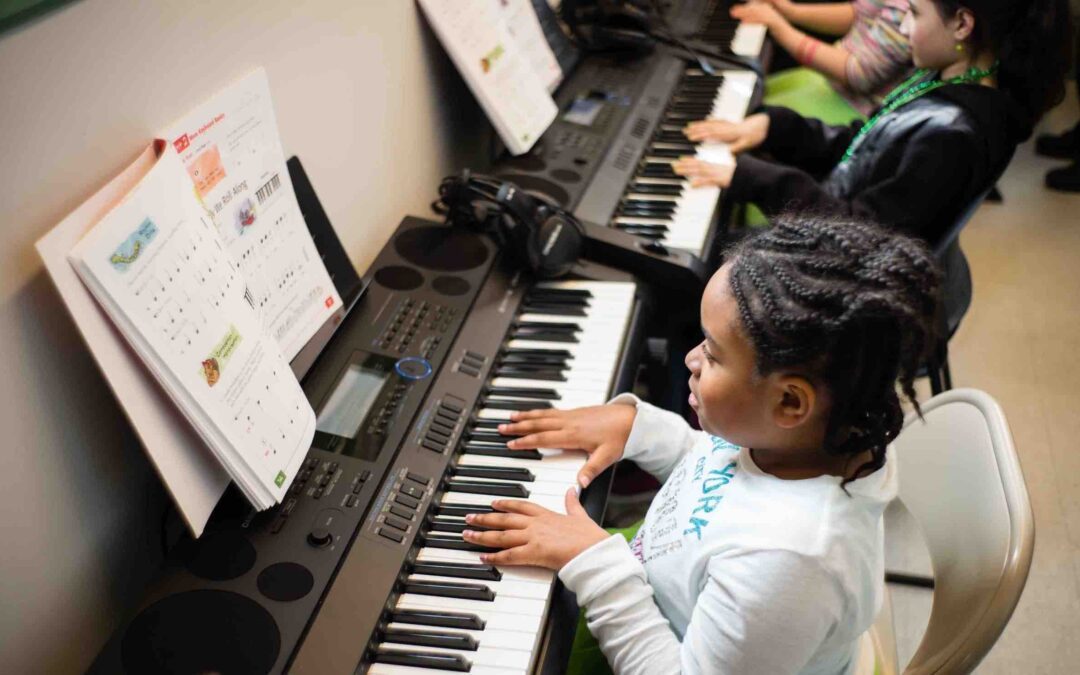The National Standards for Music Education were developed by the National Association for Music Education (NAfME). Here is the list of those music education standards administered and widely adopted in 1994:
① Singing, alone and with others, a varied repertoire of music.
② Performing on instruments, alone and with others, a varied repertoire of music.
③ Improvising melodies, variations, and accompaniments.
④ Composing and arranging music within specified guidelines.
⑤ Reading and notating music.
⑥ Listening to, analyzing, and describing music.
⑦ Evaluating music and music performances.
⑧ Understanding relationships between music, the other arts, and disciplines outside the arts.
⑨ Understanding music in relation to history and culture.
NEW STANDARDS FOR THE 21ST CENTURY
In 2014, NAfME developed the new National Core Music Standards and participated with a coalition of national arts, education, and media arts organizations to develop the new Core Arts Standards. The music standards were updated to meet specific needs of teachers and students in specialized subjects of K-12 music education. The standards emphasize conceptual understanding in areas that reflect the actual processes in which musicians engage and cultivate a student’s ability to carry out the three artistic processes:
CREATING
PERFORMING
RESPONDING
The new standards intentionally connect students’ musical achievement with thinking processes and other skills that not only align with Common Core standards, but also contribute to success in later life. The knowledge and practice a student receives through music education undoubtedly supports their future learning and development as a well-rounded person.
✓ Students need to have experiences in creating to be successful musicians and to be successful 21st century citizens. It is necessary for young people to develop the skills to plan, execute, evaluate, as well as present their work understandably and effectively. Through the process of creating music, students learn the fundamentals for creating and producing whatever they may imagine.
✓ Students need to perform – as singers, as instrumentalists, and in their lives and future careers. Performance not only includes the final showcase, but it requires skills in analysis and interpretation. Students experience the journey from practice to performance, developing skills and characteristics like strategic planning and dedication to a goal.
✓ Students need to respond to music, as well as to their culture, their community, and their colleagues. Critical thinking, analyzing, and effective judgement are all skills a student can gain through productive responsiveness. How to process and respond to one’s thoughts and feelings is also essential to becoming a well-rounded person.
NATIONAL MUSIC EDUCATION STANDARDS – THE FRAMEWORK
The new standards provide teachers with frameworks that closely match the unique goals of their specialized classes:
PreK-8 General Music
Composition / Theory
Music Technology
Guitar / Keyboard / Harmonizing Instruments
Ensemble
The music education national standards are first divided by specialty course as listed above. The pre-kindergarten through 8th grade standards are presented in a grade-by-grade sequence. The sequences advance each topic area by grade level, building on the skills and knowledge presented and evaluated. Standards for common high school music classes are organized in strands which represent the principal ways music instruction is delivered in the United States. All music education standards are written in the context of the three Artistic Processes with process components – Imagine, Plan and Make, Evaluate and Refine, Present, Analyze, Interpret – as well as Enduring Understandings and Essential Questions. The detailed content standards, definitions of these elements, and more resources are available online at NAfME.org.
SETTING UP STUDENTS FOR SUCCESS
In order for students to meet the state and national standards, music education and music programs will have start at an early age in order to have the greatest effect on students’ education. Just as with all academic subjects, students must have access to learning rudimentary concepts that can be built upon throughout their school career. General music instruction beginning in pre-kindergarten provides students with the fundamentals of melody, pitch, rhythm, and musical expression. Quality experience with pitched instruments, such as resonator bells and Orff instruments, non-pitched instruments such as hand drums and claves, other instruments such as keyboards and recorders, music textbooks and listening experiences will prepare students for further music instruction. See more research about the importance of music and music education.
Looking for more visual and performing arts standards? The National Core Arts Standards are a statement of what every young American should gain in terms of arts literacy in five disciplines—dance, music, theatre, the visual arts, and media arts. The standards apply to grades K–12 and speak to both content and achievement.
Discover how your state has adopted the arts standards and other common core standards. Please note that states routinely review their academic standards and may choose to change or add standards to best meet the needs of their students.
Thank you to NAfME (National Association for Music Education) for helping us understand the music education standards. Learn more about NAfME.

